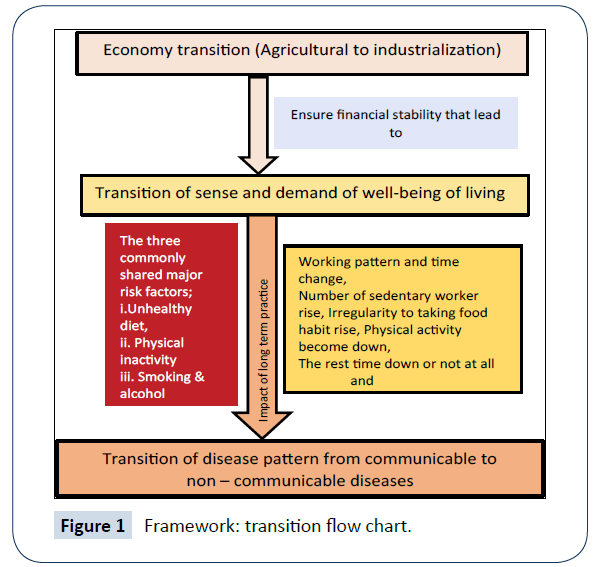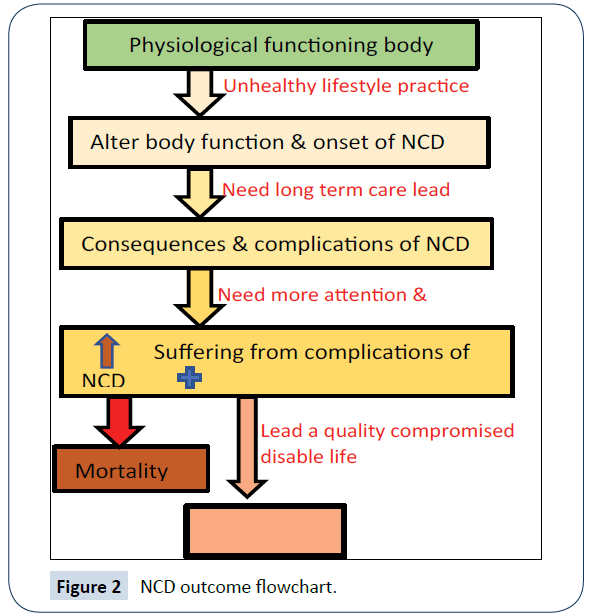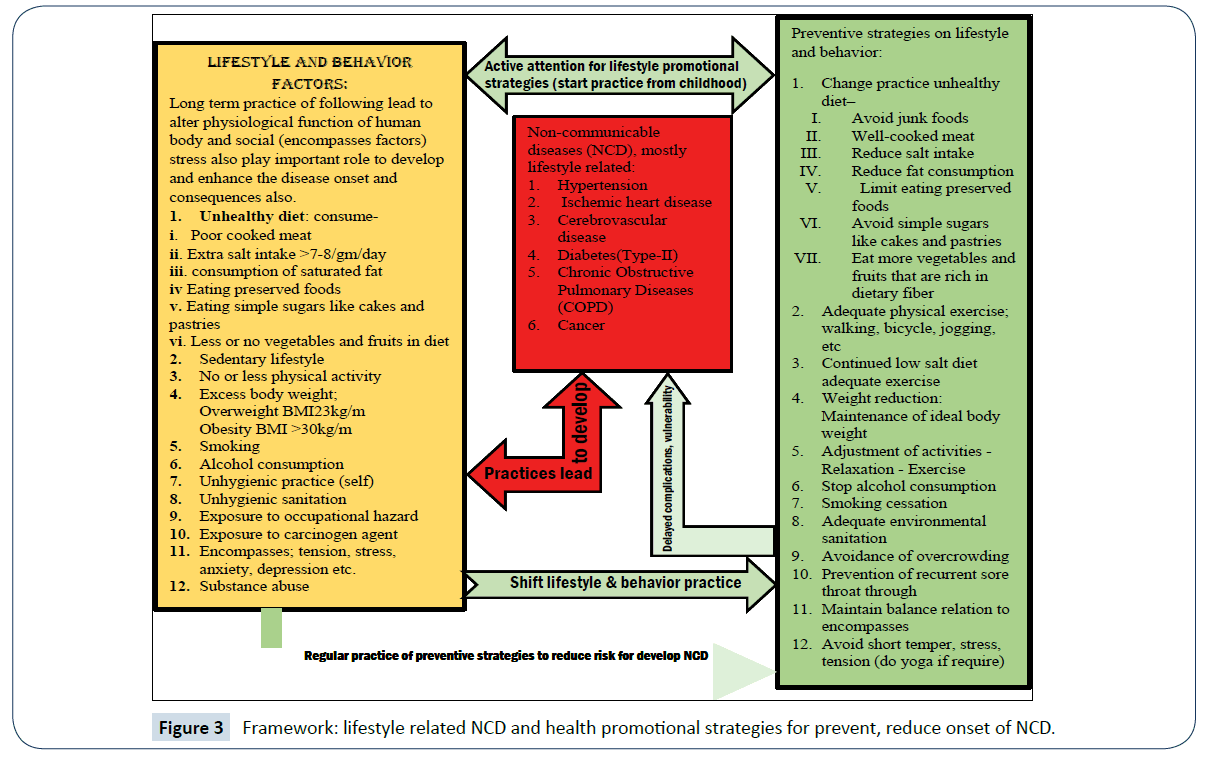Keywords
Risk factors; Lifestyle; Social pathology; Health promotional; Health care services
Abbrevation
NCD: Non-communicable Diseases; LMICs: Low and Middle-income Countries; KAP: knowledge Attitude Practice
Introduction
Globally health is considered as fundamental human right. Received health care services is also right of human being. People seeking health care services after getting complete sick that is when the pathogenic change happened in the body and the individual seems to be fallen bed. Before birth to the end of time, people were investing in health. When a mother becomes pregnant she takes extra food for fetus so human being as fetus consumes food from the mother. Along with this mother take a regular medical visit to ensure the well-being of the fetus. So, we can assume all human being consume food and health care services from fetus stage of life. The fetus delivered as a healthy baby. Irrespective of age, sex, culture, class people investing on health regularly by taking food, ensuring a clean environment, maintaining personal hygiene, doing exercise, going gym and so on. But most of the people not concerned about this investment, they take it as a regular daily activity. For this, investment on health at the healthy time, most of the people didn’t give concern on healthy practice for keep the healthy state of health and gradually fall in sickness. When people fall in sickness the investment on health rise three to five or sometimes more fold higher than investment at the healthy state [1-3].
Before eighteen centuries globally people were suffered from communicable diseases with the discovery of vaccine and rises of awareness among the mass populations reduce, control and eliminate most of the communicable diseases from the globe.
There is a strong connection between the transition of the economy, the transition of well-being sense and transition of disease. Beside the flowchart describing the connection. From eighteen centuries onward, the great change of economy occurs. The economy of globe gradually shifts from major source agriculture to industry based. With this industrialization income of peoples were rise. The purchasing power capacity of the peoples of the globe also rises. People get financial stability. The sustainable financial independence changes the test and demand for a living. This change plays an important role in changes the lifestyle and behavior pattern of human being. The modernization takes place. Peoples working pattern and time were changed, food taking behavior also changed, physical activity and rest – sleep was changed. A number of sedentary worker increases, irregularity in taking food habit rise, physical activity becomes down, people forget the rest time and go to let night sleep. The transition of the economy leads to the transition of people well-being sense and test which leads to developing transitions of disease pattern. Over the decade important three transitions actually take place in our earth. Economic transition, well-being transition in terms of standard of living, level of living and quality of life and impact of first two transitions actually lead to a transition of disease pattern [4,5]. Peoples response to these transitions give rise the onset and suffering from non-communicable diseases (Figure 1).

Figure 1: Framework: transition flow chart.
The concept of communication for health in terms of health promotion rises during the period of cholera out brake. Ebb of health status due to cholera in London on 1832, draw the attention of policymakers to take action for the mass population. The leadership of great cholera epidemic investigation was given to lawyer Edwin Chadwick (1800-1890). His report focused the contemplation of government to boost up public health and improve mass population awareness to keep healthy health status. To give concern on this several initiative and strategies were taken at late eighteen centuries onward. Presently government, development partners in terms of international organizations and national organizations of the globe working to improve awareness of mass population. They work on very specific issues in terms of risk factors, risk practices and habits responsible for developing long-term chronic and life-threatening non-communicable diseases (NCD). Almost abolition of communicable diseases and increase the utilization of health care service providing facilities were the impact of this promotional activities. This indicates a concern to keep healthy health status people give priority to their health and take health care services, which address the secondary level of prevention (early diagnosis and treatment) mention in public health. When an individual fall in any sorts of diseases especially long-term non – communicable diseases then that individual lead a quality compromised life till the end of time [6,7].
Contemporaneity European specialty on social medicine was revived by Alfred Grotjahn (1869-1931). He describes the importance of social factors in the etiology of disease as social pathology. Some experts describe social pathology as geographic pathology and population pathology. These actually said the role of social factors, social consequences that responsible for developing diseases. And this is considering as the orientation of medicine to the changing needs of human beings and society.
So, well-being (unhealthy lifestyle and behavior) practices that lead physiological changes and social pathology combinedly actually responsible for the onset of non-communicable disease. Beside the flowchart showing the connection and outcome of the non-communicable disease. The human body is a systemic organized biological product. Healthy health status depends not only on the physiologically functioning body but also on social factors and on individual encompasses factors. With the transitions and modernizations, human being changes their lifestyle and behavior. The responses of the body to changes in lifestyle and behavior give rise to develop diseases related to biological cell, tissue, organs and also diseases related to social stress which is well known as mental health. The onset of NCD starts with altering physiological function of the human body (cell, tissue, organ) due to unhealthy lifestyle practices. If an individual takes regular treatment along with healthy lifestyle practices able to delay or even stop consequences and complications of NCD. But most of the cases NCD patients suffer from consequences and complications of NCDs. Encompasses taking care failed to keep patience. Thus, along with diseases, social stress added. That makes the case worse and final outcome either mortality (premature death before 60 year of age) or morbidity, lead a quality-adjusted disable life (Figure 2) [8-10].

Figure 2: NCD outcome flowchart.
NCDs were estimated to have caused 68% of the world’s 56 million deaths in 2012 and of these 28 million occurred in LMICs. The burden of NCDs can be reduced through effective preventive measures –up to 30% for cancer and 75% for cardiovascular diseases. Premature deaths from NCDs range from 22% among men to 35% among women in low-income countries. The mortality rate—deaths per 100,000 population of all ages—is 705 for males and 520 for females for the world as a whole. In high-income countries, 13 percent of deaths due to NCDs were premature, before the age of 60. However, in the middle-income countries, the proportion of premature NCD mortality is 28 percent, and in low-income countries, it is 41 percent. The economic impact of NCDs has been assessed by the World Economic Forum, which projects the cumulative impact by 2030 of $47 trillion or 5 percent of the global GDP. The World Bank has stated that "the developing countries cannot afford to treat their way out of this." With increasing life expectancy, urbanization and lifestyle changes have brought about a considerable change in the health status of world populations. Globalization and social change have influenced the spread of non-communicable or lifestyle/ degenerative diseases by increasing exposure to risk. To prevent the onset of NCDs family history that is the role of the chromosome is an unknown and aging process where degenerative changes occur. These two are non-modifiable risk factors which people cannot change [11].
There were about ten papers selected from a google search, read out very carefully to understand the connection of lifestyle and behavior and the onset of non-communicable disease. Then the interconnection is described in the flowchart below. The connection among the lifestyle and behavior related risk factors that are sometimes called as unhealthy lifestyle & behavior and NCDs. In yellow box enumerate risk practices related to lifestyle and behavior, the preventive strategies of risk practices mentioned in green box. Unhealthy lifestyle and behavior practice for longterm responsible for altering physiological function of the cell, tissue, and organs of human body. This lead to developing a different type of disease mention in the red box. After the onset of disease if risk practice does not control then the early onset of consequences occur which lead premature death or mortality and or disability. The best possibilities of health promotion strategies on lifestyle and behavioral changes to reduce the number of onset of NCDs patient would be;
I. Start healthy lifestyle and behavior practices from childhood (Primordial prevention): motivate the mass population to give concern on healthy lifestyle and behavior practices of their children at their early childhood (mentions in the green box). This regular practice will motivate to develop healthy knowledge, attitude and practice at adulthood on health issues. This will ensure not to develop and suffer from so many NCD.
II. Delayed complications and vulnerability: once an individual diagnosed as suffered from NCD mention in the red box need to the cessation of unhealthy lifestyle and behavior. If able to change the lifestyle mention in the green box, it will delay the onset of consequences, complication, and vulnerability of NCD.
III. Shift lifestyle and behavior practice: here an individual can change his/her unhealthy lifestyle and practices before the onset of NCDs. This may play an important role to avoid the onset of NCDs. For example, unhealthy food (junk food) consumption at childhood practice shifts to consume healthy balanced diet at early young age. For this shift, strong mass awareness needed to develop (Figure 3).

Figure 3: Framework: lifestyle related NCD and health promotional strategies for prevent, reduce onset of NCD.
IV. Regular practice of preventive strategies: here it is in yellow arrow going from healthy lifestyle and behavior to yellow box that’s are unhealthy lifestyle behavior. There was some signal for developing NCDs like; broader line blood pressure level (lead to developing Hypertension), Glucose Tolerance Test positive (3-5-fold higher risk for developing Diabetic-II), etc. An individual having thresholds or at broader line stage need to shift at practices of healthy lifestyle and behavior. This will have reduced to develop onset of NCDs.
Framework of Unhealthy Lifestyle and Behavior Practices of Peoples
The framework also shows the connection between unhealthy lifestyle and behavior practices of peoples that are modifiable risk factors for developing NCDs. Practices of unhealthy diet, sedentary lifestyle and physical inactivity lead to developing overweight, obesity. It is responsible for the change in blood vessels by elevating cholesterol level & thickening of blood vessels wall which caused to developed hypertension subsequently lead to developing ischemic heart disease, myocardial infarct (MI) and cerebrovascular accident (CVA). Likewise, excess body weight is responsible for developing type-II diabetes and consequence of this disease is vital organ damage especially eye, kidney, heart and periphery micro arterioles. Smoking, exposure to dust (air pollution) lead to developing COPD. Smoking, alcohol abuse, exposure to carcinogen agent lead to developing cancer of different organ. Individual encompasses responsible to deteriorating mental state. So, the practice of one lifestyle and behavioral risk factor able to develop life-threatening NCD. All of the risk factors are modifiable. An individual can change these habits, practices which able to prevent premature death from NCDs and or lead quality-adjusted life.
Discussion
NCD is a worldwide concern. World leaders, policymakers notice by this worse situation. All work for improveing the situation but till KAP for NCD at household and individual level not satisfactory. The mortality and morbidity due to NCDs rise day by day. Industrialized countries where these risks are often higher in lower income groups, in developing countries the levels are often higher in higher income groups. The World Health Organization focused on the four NCDs -diabetes, cardiovascular disease, chronic respiratory disease, and cancers. These four NCDs are responsible for 80 percent of the NCD mortality rate, and they also tie to four shared underlying risk factors unhealthy lifestyle and behavior. For example, smoking is responsible for 71 percent of lung cancer deaths, 42 percent of chronic respiratory disease, and 10 percent of cardiovascular disease (mortality). Likewise, excess body weight is linked to high blood pressure, type 2 diabetes, and heart disease. A sedentary lifestyle is estimated to result in a 20-30 percent increase in all-cause mortality.
The Philippines declared healthy lifestyle practice will reduce the onset of 50% NCDs and China declared lifestyle able to the reduce the onset of 30% NCDs in their country. Other governments, academic institutions, social organizations and other stakeholders realize the scope of the challenge and are taking action to respond. An efficient, effective and impactful collaborative action between the private and public sectors needed focus on influencing individual behavior. However, achieving this combination requires deliberate action from stakeholders and individuals alike. A more human-centric system moves the responsibility and the capacity for initiative towards individual’s choices that encourage healthy behavior. It shifts emphasis towards awareness and prevention rather than chiefly emphasize treatment of preventable disease.
References
- Park K (2011) Park’s textbook of preventive and social medicine (21st Edn). Pp: 868.
- https://www.ateneo.edu/asg/publication/02/08/14/health-promotion-and-non-communicable-diseases-philippines-current-status
- World economic forum (2017) Human-centric health: behaviour change and the prevention of non-communicable diseases, pp: 1-31.
- Kulik J (2013) Reducing the economic burden of non-communicable diseases in the BRICS: lessons from Brazil. BRICS Research Group, University of Toronto.
- Yue X (2015) Community-based integration of management of non-communicable diseases in China. Chron Dis Transl Med 1: 133-140.
- Ri-Na S, Hui-Xia Y (2015) Comprehensive understanding of developmental origins of health and disease concepts: early intervention to non-communicable diseases in China. Chronic Dis Transl Med 1: 141-144.
- Dobe M (2012) Health promotion for prevention and control of non-communicable diseases: unfinished agenda. Indian J Public Health 56: 180-186.
- Nugent R (2015) Benefits and costs of the non-communicable disease targets for the post-2015 development agenda. Copenhagen Consensus Center, pp: 1-25.
- Villaverde MC, Vergeire MR, de los Santos MS (2012) Health promotion and non-communicable diseases in the Philippines: current status and priority policy interventions and actions. Technical report, pp: 1-53.
- https://www.health.gov.au/internet/main/publishing.nsf/Content/sfwnc
- Wendy B (2015) The burden of non-communicable diseases in the developing world. Agency for healthcare research and quality, Rockville, MD.




